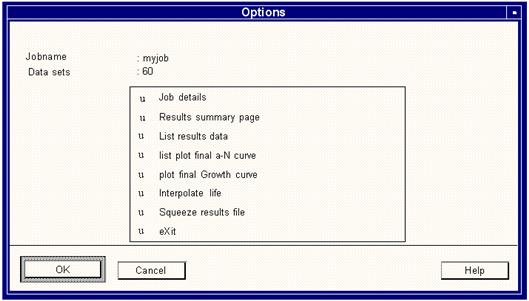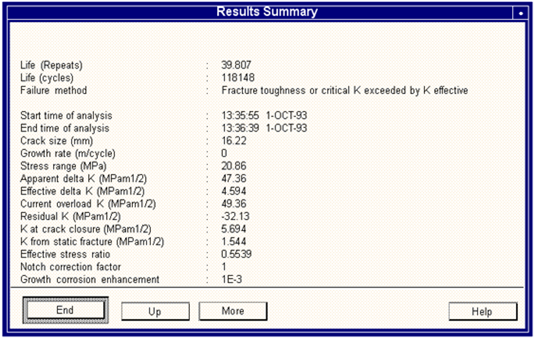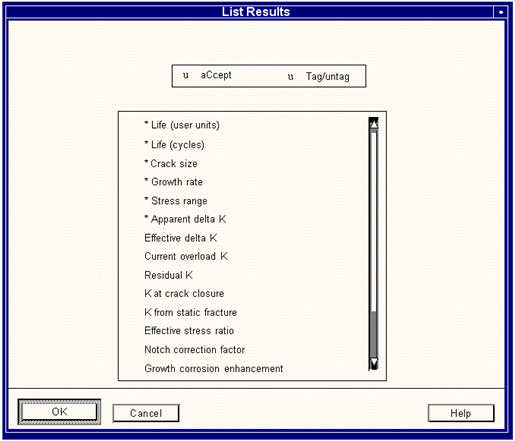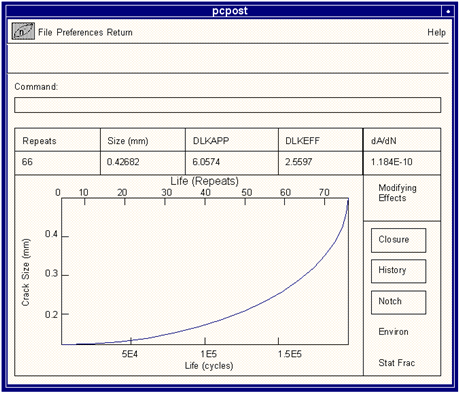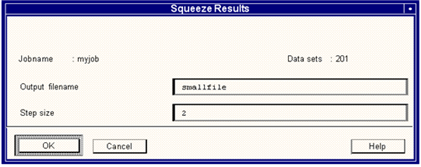XXXXXXXXXXXXXXXXXXXXXXXXXXXXXXXXXXXXXXXXXXXXXXXXXXXXXXXXXXXXXXXXXXXXXXXXXXXXXXXXXXXXXXXXXXXXXXXXXXXXXXXXXXXXXXXXXXXXXXXXXXXXXXXXXXXXXXXXXXXXXXXXXXXXXXXX''"> Reviewing Results (PCPOST)
When performing a crack growth analysis, this option executes the external MSC Fatigue module PCPOST (a Tabular and Graphical Postprocessor for the crack growth analysis) which allows various listing options and final graphical displays for the specified results file. PCPOST may also be run from the operating system prompt by typing the symbol pcpost.
PCPOST is designed specifically for postprocessing the results of cycle by cycle fatigue crack growth analysis carried out by MSC Fatigue. The crack growth analysis produces a results file which contains a “snapshot” of the situation at equally spaced intervals of cycles throughout the predicted life. This file may be large due to the possibly lengthy operation of the crack growth modeling. The results file preserves the full description of the crack growth analysis run in the form of 14 different parameters recorded at each interval. The program operates interactively in motif or mask mode and menu selections are made according to the rules defined in
Module Operations (Ch. 17). The PCPOST module has four functions:
1. To list the data on screen and the session file for subsequent report preparation.
2. To display the two main crack growth analysis graphs and produce hard copies of the same for inclusion in a report.
3. To interpolate the crack size-cycles data for sensitivity studies, inspection strategy or defect assessment purposes.
4. To compress unnecessarily large crack growth results files.
The 14 parameters saved at each “snapshot” are indicative of the complexing effects being accounted for in the crack growth analysis. These parameters are listed below:
Life in user units | Life in cycles |
Crack size | Growth rate |
Stress range | Apparent delta K |
Effective delta K | Current overload K |
K at crack closure | Residual K |
K from static fracture | Effective stress ratio |
Notch correction factor | Growth corrosion enhancement |
A full description of the significance and mathematical derivation of these parameters is given in
Fatigue Theory (Ch. 15).
PCPOST Module Opera tion
When first invoked PCPOST appears displaying two forms.
Figure 7‑40 PCPOST Utility Form
The top, small form is a generic form and allows for general program control. Once initiated, PCPOST will present the user with a number of menus and questions. The second form, however, will ask for a valid jobname as shown below.
Figure 7‑41 PCPOST Jobname Prompt
When PCPOST is spawned from the MSC Fatigue Results form the current jobname is automatically passed and appears as the default as in
Figure 7‑42.
Enter the name of a MSC Fatigue jobname.crg results file containing crack growth results. PCPOST reads these files which are produced by PCRACK. A jobname must be entered. If multiple jobnames exist the List button may be used to obtain a listing of available results files.
Once a file name has been supplied, and then confirmed by clicking OK, the main PCPOST form will appear. The main menu will appear as shown in
Figure 7‑42.
Figure 7‑42 The PCPOST Main Menu Form
The menu options are described below.
Job Details
This option provides information on the file which has been highlighted in the file list. The information detailed is:
1. Jobname
2. Number of data sets
3. Job description
Results Summary Page
This option presents the summary of the final situation when the crack growth analysis was halted, (i.e., when the failure criterion was met). An example of this display is shown in
Figure 7‑43.
Figure 7‑43 .The PCPOST Results Summary Screen
List Results Data
This option leads to a list of the columns of information saved in the results file. The user is presented with a tag submenu which allow the selection of up to 6 columns of data to be listed to the screen and the session file. The tagging submenu and selection list are shown in
Figure 7‑44.
Figure 7‑44 Tagging Submenu and Selection List
The * signifies that these parameters have been selected (or tagged). The first 6 items are automatically tagged when this option is selected. They may be untagged or tagged by highlighting the relevant item and pressing the Tag/untag toggle. The table is produced by pressing the Accept button.
Plot Final a-N Curve
The final crack length (a) versus number of cycles (N) curve is presented on the screen together with the additional parameters which indicate the status at the point when the analysis terminated. This curve may be saved in the
.plt file by invoking the hardcopy option under the file menu of this window. An example of this final A-N screen display is shown in
Figure 7‑45.
Figure 7‑45 A PCPOST Graphical Screen
The pull-down menus at the top of this form provide for some graphical preferences. These as well as the commands that may be entered in the Command line are detailed in
Module Operations (Ch. 17) for the Motif interface.
Plot Final Growth Curve
This is identical to the previous option except that by selecting this option, the final crack growth rate (da/dN) versus driving force (

) curve is presented on the screen together with the additional parameters which indicate the status at the point when the analysis terminated.
This curve may be saved in the .plt file also by invoking the hardcopy option under the File menu of this window.
Interpolate Life
This option allows for the specification of an initial and final crack length, and the life for these two parameters will be reported. Multiple initial or final crack sizes may also be entered, separated by commas, spaces, or other separators, and the resulting lives listed. The default crack sizes will be the initial and final crack sizes used in the original crack growth analysis. The interpolate form is shown in
Figure 7‑46.
Figure 7‑46 The Interpolate Screen
It is possible to interpolate life beyond the crack size limits of the initial calculation. However, such interpolation is only approximate as the crack size-life relationship is both nonlinear and bounded by certain physical constraints.
Squeeze Results File
The results file from a crack growth analysis may be unnecessarily large due to the fact that the update frequency for this file is set before the length of the analysis or component life is known. This option allows the decimation or reduction of this file for archiving purposes or simply to save space.
Figure 7‑47 The Squeeze Results Screen
A new output file name will be requested. (This cannot be the same as the input file for security reasons.) The number of values to select is then determined by asking for a step size.
If the answer here was 10, every tenth set of values (i.e., every 10th entry) in the jobname.crg file would be saved in the new file and the file would be about 10% of the size of the original file.
eXit
This option will terminate the PCPOST program.



